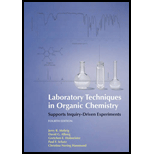
(a)
Interpretation:
The disadvantages of the use of too little drying agent should be determined.
Concept introduction:
Drying agents are used to remove water from organic solvents. Mostly anhydrous drying agents are used that react with water to form insoluble hydrates in organic solvents and can be easily removed by filtration. Parameters that are considered to choose an effective drying agent are as follows:
- Capacity: The maximum number of moles of water molecules that can be trapped by a salt or drying agent defines its capacity.
- Efficiency: The amount of water left behind in the organic solvent after the drying process is called efficiency.
- Speed of removal of water: Time taken by the drying agent to form hydrate determines the speed of removal of water.
- Chemical inertness: Drying agents should be chemically inert that is it should not react with the organic solvent and the organic compounds dissolved in it.
(b)
Interpretation:
The disadvantages of the use of too much drying agent should be determined.
Concept introduction:
Drying agents are used to remove water from organic solvents. Mostly anhydrous drying agents are used that react with water to form insoluble hydrates in organic solvents and can be easily removed by filtration. Parameters that are considered to choose an effective drying agent are as follows:
- Capacity: The maximum number of moles of water molecules that can be trapped by a salt or drying agent defines its capacity.
- Efficiency: The amount of water left behind in the organic solvent after the drying process is called efficiency.
- Speed of removal of water: Time taken by the drying agent to form hydrate determines the speed of removal of water.
- Chemical inertness: Drying agents should be chemically inert that is it should not react with the organic solvent and the organic compounds dissolved in it.
Want to see the full answer?
Check out a sample textbook solution
Chapter 11 Solutions
Laboratory Techniques in Organic Chemistry
- Fill in the following blanks that describe using sodium sulfate for a drying agent: Sodium sulfate dry's at a rate, requiring contact time but, it has capacity for adsorbing water. A slow, short, low B fast, long, low C slow, long, high D. fast, short, lowarrow_forwardPROCEDUREA. Clean and carefully weigh 2 strips of Cu, 2 strips of Fe, and a strip of Zn.B. Connect 1Cu strip and 1Fe strip together. Place them in a beaker containing salt water. C. Connect another Fe strip to one end of a Zn wire. Connect the other Cu strip to the other end of the same Cu wire.D. Place the connected strips in another beaker containing the same concentration of salt water.E. Set the mixtures aside for a couple of days.F. Wash the strips. Dry them. Weigh each strip.G. Explain results.arrow_forwardWhat are pipeline slurry systems? How do they function?arrow_forward
- What Is Batch process?arrow_forwardPrior to fat analysis, two samples: Sample 1 and Sample 2 with the initial weight for each sample=2.50g. After pre-dried, samples were grinded and reweighted; s1-2.15g and s2=2.11g. Samples were placed in dried glass wool in each thimble and placed extractor for 4-5 hours. Samples were then dried and cooled in desiccators before another weight recorded. The weight for s1=93.51g and for s2=93.78g #Weight of round bottom flask (with glass wool+ thimble) (g) = 92.00 #Weight of round bottom flask (g) =91.00 1) Calculate the percentage of dried fat in s1 2) Calculate the percentage of dried fat in s2. 3) Sample 3 have dried fats of 50%. Identify the correct sequence from the highest to the lowest % of dried fats in sample.arrow_forwardIf you have an empty burette in a burette clamp, in what order do you do these steps to fill the burette with liquid (either water for washing, or the titrant)? Drag the steps below into the correct brder. Step 1: Step 2: Step 3: Step 4: Step 5: Step 6: Step 7: Close the tap. Remove burette from clamp. Hold burette with top below eye level. Put plastic funnel into top of burette. Fill burette with liquid. Remove plastic funnel. Return burette to burette clamp.arrow_forward
- What paint ingredients in the artwork we see in the film and how is the paint mixed (tool?)?arrow_forwardWhat are two characteristics of good recrystallization solvent for given compoundarrow_forwardA type of cast iron containing 3.1-4 wt% C and 1.7-3 wt% Si. * a. Compact graphite b. Malleable cast iron c. Grey Cast iron d. White cast ironarrow_forward
 Macroscale and Microscale Organic ExperimentsChemistryISBN:9781305577190Author:Kenneth L. Williamson, Katherine M. MastersPublisher:Brooks Cole
Macroscale and Microscale Organic ExperimentsChemistryISBN:9781305577190Author:Kenneth L. Williamson, Katherine M. MastersPublisher:Brooks Cole Chemistry for Engineering StudentsChemistryISBN:9781337398909Author:Lawrence S. Brown, Tom HolmePublisher:Cengage Learning
Chemistry for Engineering StudentsChemistryISBN:9781337398909Author:Lawrence S. Brown, Tom HolmePublisher:Cengage Learning

